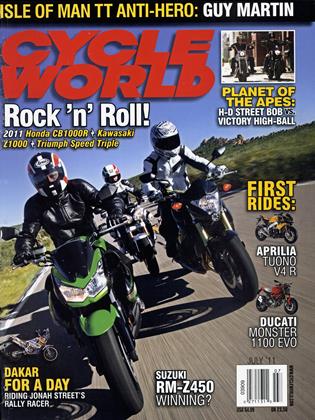2011 SUZUKI RM-Z450
CW RIDING IMPRESSION
Fresh off two national championships.
RYAN DUDEK
AS FAR AS NEW MOTORCYCLES WERE concerned, Suzuki was almost invisible in the U.S. last year. Only three motocrossers and one enduro bike were in the 2010 lineup, and all other models, street and dirt, were leftover 2009s.
But on the racetrack, Suzuki was anything but invisible. Ryan Dungey won the 2010 AMA Supercross and Motocross championships on an RMZ450, sweeping both of what many consider the world’s most prestigious MX titles. There are reasons Dungey holds those number-one plates, and they have nothing to do with Makita tools or Rockstar energy drinks.
Give much of the credit instead to the RM-Z’s seriously impressive 449cc,
. i liquid-cooled engine, and to the Suzuki engineers who developed *. / •' it. Evidently, they * >
weren’t sitting idle while new-bike sales were tanking.
Actually, the engine was updated last year with new cam profiles and intake tracts that produced a broader powerband. For 2011, it got further refinements that include a quieter muffler to meet the AMA’s new 94 dB sound limit. The ECU and the cam timing for both intake and exhaust were then changed to complement the exhaust, and the compression ratio was increased from 12.2:1 to 12.5:1. The result of these changes is linear throttle response and an exceptionally smooth powerband. And by “smooth,” I don’t mean “slow”; there’s strong power everywhere, and it’s the kind you can use just about anywhere.
Thanks in part to the engine’s tractabilitÿ, the rear tire always feels like it’s biting down and getting traction. The engine response is so nearly perfect that it doesn’t leave you guessing when it comes to timing jumps. When I apply a certain amount of throttle off a jump on other 450s, I usually land close to my intended area. But when 1 do it on the Suzuki, I know that I’m always going to land in the exact same spot. That kind of predictable, repeatable delivery makes fast lapping fun and easy. The five-speed transmission’s gear ratios help here, too, since they leave no gaps in the rev range, although shifting is a tad notchy.
If you feel the need to change the RMZ450’s injection mapping, you can do so simply by plugging in either of two included couplers; one makes the mixture richer, the other makes it leaner. But never once did I feel that the power delivery needed to be different. If you’re anything like me, those couplers will just get lost or smashed at the bottom of a toolbox.
Keeping up with tradition, the RM-Z has great steering and cornering traits. At a measured dry weight of 242 pounds, it is one of the heaviest 450 MXers, but the weight disappears when you’re flicking it through corners. The front wheel always tracks exactly where it is pointed without any pushing or diving. Just as with the engine, the RM-Z’s precise and predictable cornering makes for one easy-toride motocrosser.
Chassis-wise, the only thing different this year is a front brake caliper with twin aluminum pistons. The frame underwent a few changes last year, and so did the suspension; the fork got stiffer springs. But the 2011 RM-Z could use even stiffer springs at both ends, because the fork and shock bottomed more often for me than other 450 MX bikes.
Neither does the fork provide that nice, plush feeling all through the stroke that we have come to expect these days.
Those suspension issues are the only complaint I have about the new Suzuki, and they might not exist for some riders. Besides, stiffer springs are a relatively easy and inexpensive fix.
So, overall, the $8149 2011 RM-Z450 has been greatly improved over the past couple of years and now is back in a big way. Formerly a middle-of-the-class 450, it now has an engine that chums out nearly perfect power matched with incredible steering and cornering ability. It’s a combination for a winning motorcycle.
Just ask Ryan Dungey. U
 View Full Issue
View Full Issue
More From This Issue
-
 Up Front
Up FrontThe Mysteries of Grandpa
JULY 2011 By Mark Hoyer -
 Roundup
RoundupA Shift In Changing Gears
JULY 2011 By Kevin Cameron -
 Roundup
RoundupBmw S600rr
JULY 2011 By Mark Hoyer -
 Roundup
Roundup“chrome” Hawk
JULY 2011 By John Burns -
 Roundup
RoundupCycleworld.Com Poll Results
JULY 2011 -
 Roundup
Roundup25 Years Ago July 1986
JULY 2011 By Blake Conner








